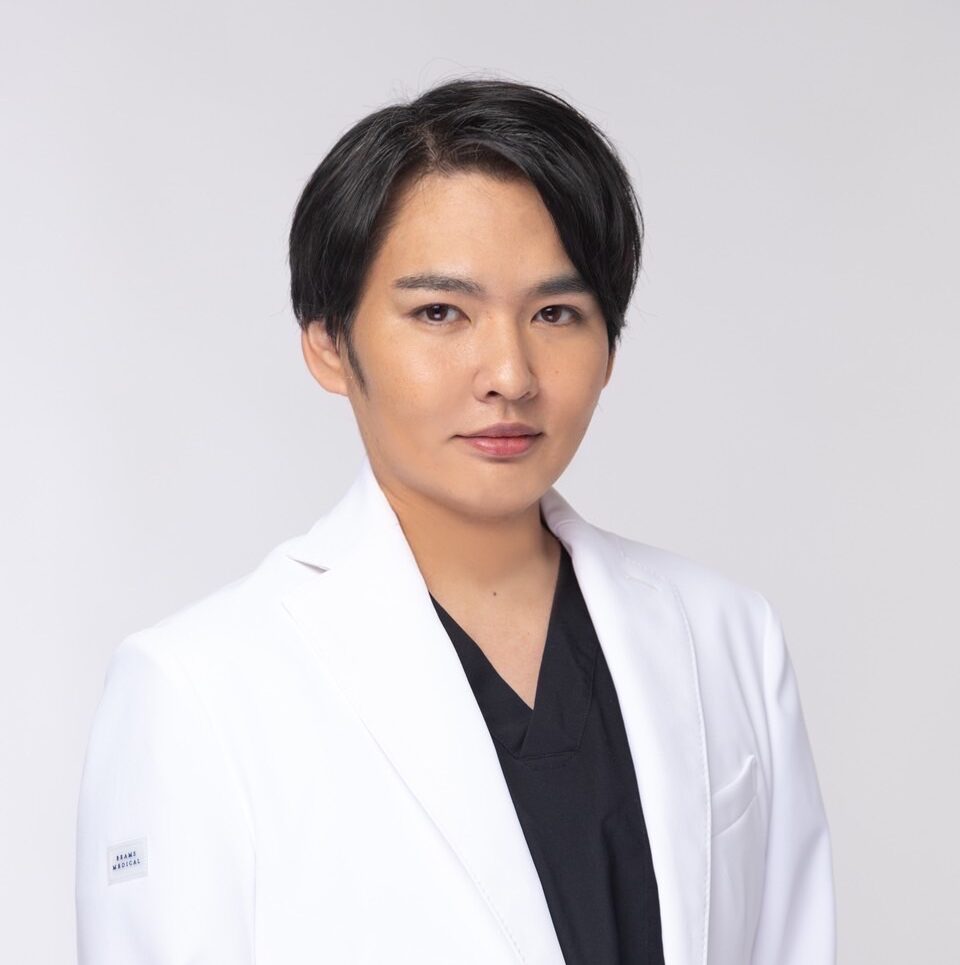As cosmetic medicine evolves, hyaluronic acid and Botox are among the most popular procedures accepted by many people. However, many people wonder, "Which is right for me, hyaluronic acid or Botox?" Many people wonder, "Which is right for me? Here, we will explain in detail the characteristics, effects, areas of application, and how to choose between the two.

Graduated from the Faculty of Medicine, National Kumamoto University. After serving as the director of major beauty clinics in Japan, etc., he opened Aladdin Aesthetic Clinic in 2023. He is a professional in aesthetic medicine with a doctorate in anti-aging research and many years of experience. With the motto of "Toward the realization of cosmetic medicine without lies," he aims to be the "Only One" together with his patients.
What is Hyaluronic Acid?

Hyaluronic Acid is a polysaccharide originally found in the human body and is distributed in many parts of the body, including the skin, joints, and eyes. This natural component has many uses in both beauty and health because of its high water-holding capacity.
Hyaluronic acid is a biopolymer chemically composed of sugar chains (polysaccharides). The most important property of this component is its extraordinary "water-holding capacity": 1 gram of hyaluronic acid has the ability to hold up to 6 liters of water. Therefore, hyaluronic acid not only moisturizes the skin, but also hydrates and plumps it.
Effects and Features
Hyaluronic acid injections have many cosmetic benefits. One of them is volume enhancement. Injections into areas where volume is desired, especially around the cheeks, lips, and eyes, can eliminate facial irregularities and sagging, and create a more three-dimensional expression.
Hyaluronic acid also has an excellent moisturizing effect on the skin. Not only does it prevent fine lines and sagging caused by dryness, but its high moisturizing ability softens the skin and keeps it hydrated throughout the day.
In addition, this component contributes to the overall improvement of skin quality. By acting not only on the surface layer of the skin, but also on the dermis layer, the overall quality of the skin is enhanced. As a result, the skin becomes brighter, firmer and more elastic.
Finally, hyaluronic acid is an ingredient that occurs naturally in the human body and, as such, has a very low risk of allergic reactions. This is why it is considered a safe option for many people.
Why is hyaluronic acid in the spotlight now?
Hyaluronic acid is of particular interest in modern aesthetic medicine for several reasons. First, coupled with advanced cosmetic technology, hyaluronic acid offers a very natural-looking result. The risk of creating unnatural bulges and expressions as in the past has been greatly reduced, and cosmetic results can be achieved in a way that is more harmonious with one's own skin type and facial features.
Second, it is also important to note that downtime is short. Because no surgery is required, recovery time after the procedure is virtually nonexistent, allowing patients to return to their daily routines immediately. This makes it a very attractive option, especially for today's busy people.
In addition, the effects of hyaluronic acid last for a period of time, but are not permanent, so there is no pressure to leave some significant change in one's face or body forever. This is also a factor that gives many people a sense of security.
The ease of the procedure is also attracting attention. In many cases, the procedure can be completed in a short amount of time and requires little or no special advance preparation or post-procedure care. This makes hyaluronic acid an easy and effective cosmetic treatment option for many people.
For these reasons, as aesthetic medicine has evolved, hyaluronic acid has become a very attractive option for those seeking more natural-looking results, shorter downtime, longer-lasting effects, and ease of application.
What is Botox?

Botox (botulinum toxin) is a formulation containing botulinum toxin, a medical grade botulinum toxin, as its main ingredient, and is primarily effective in temporarily restricting muscle movement. This can inhibit wrinkles on the face and excessive movement of the facial muscles. It is used not only for cosmetic purposes, but also for medical problems such as spasms and excessive sweating.
Effects and Features
For many people, Botox is commonly used to improve wrinkles and for other medical applications. It is particularly effective in improving wrinkles in the upper part of the face, for example, the forehead, between the eyebrows, and at the corners of the eyes. This is because Botox restricts the movement of the facial muscles, thereby making wrinkles less noticeable.
As for the durability of the effect, there is a point where it is temporary and usually lasts only 3-6 months. Therefore, if a lasting effect is desired, re-injection is necessary. Also, while Botox has an immediate effect, it does not appear immediately after injection. Generally, clear effects begin to appear within one to two weeks.
In terms of downtime, in many cases there is very little. This is because the procedure is very easy to perform and in many cases patients can return to their daily activities immediately after the procedure. Furthermore, Botox has a variety of medical uses beyond cosmetic. For example, it can be used to treat excessive sweating (hyperhidrosis), seizures, and migraine headaches.
Why Botox?
There are several reasons why many people choose Botox, the most notable of which are its low risk and immediate results. Botox has been highly researched medically and is considered to have relatively low side effects and risks. This provides peace of mind, especially for those who are new to cosmetic medicine or who want to undergo cosmetic procedures easily.
In terms of immediate results, Botox is also suitable for those who desire a quick change, as it produces clear results within one to two weeks. These short-term effects are very useful before a special event or when a sudden boost of confidence is needed.
In addition, Botox is also very attractive in that it provides a natural-looking result. By fine-tuning the movement of the facial muscles, it can naturally soften wrinkles that appear in the upper part of the face and maintain an excellent overall facial appearance. This is very attractive to those wishing to avoid an artificial look.
Main differences between hyaluronic acid and Botox
Although both hyaluronic acid and Botox are very popular in cosmetic medicine, there are some important differences between the two in their purposes, effects, and risks. Each is explained in detail below.
| point | hyaluronic acid | Botox |
|---|---|---|
| Purpose or area | Volumizing and skin moisturizing. Cheeks, lips, eye area, etc. | Improvement of wrinkles, limitation of muscle movement. Forehead, between eyebrows, corner of eyes, etc. |
| Duration | Immediate effect, lasting 6-12 months | Effective after 1-2 weeks, lasting 3-6 months |
| down time | Less. Temporary swelling and bruising possible. | Almost none. Rarely with muscle over-relaxation. |
Purpose and area of use
Hyaluronic acid and Botox are commonly used ingredients in cosmetic medicine, each with different purposes and effects.
Hyaluronic acid is mainly used to increase volume and moisturize the skin. It is especially suitable for areas where volume is desired, such as the cheeks, lips, and eye area. Hyaluronic acid has a high ability to moisturize the skin and prevent fine lines and sagging caused by dryness.
Botox, on the other hand, is primarily intended to improve wrinkles and limit muscle movement. For this reason, it is particularly effective for wrinkles caused by facial muscles, especially in the forehead, between the eyebrows, and at the corners of the eyes. Botox works by fine-tuning the facial muscles to naturally soften wrinkles.
Each of these ingredients has its own specific uses and benefits, and when used appropriately, can provide significant cosmetic improvements.
Duration and speed of effect
Hyaluronic acid and Botox each have different durations and speeds of effect.
For hyaluronic acid, the effects are almost immediate. Once applied, the effects usually last 6 to 12 months. However, the duration may vary depending on the product used and the area being treated.
On the other hand, the effects of Botox do not appear immediately after injection, but a clear improvement is usually seen one to two weeks later. The effect usually lasts 3 to 6 months, after which re-injection is often necessary.
Differences in downtime and side effects after treatment
There are some differences in downtime and side effects after hyaluronic acid and Botox procedures.
With hyaluronic acid, downtime is usually minimal. Temporary swelling and bruising may occur at the injection site after injection, but in most cases these symptoms resolve within a few days.
Botox, on the other hand, usually requires almost no downtime, and in many cases, patients can return to their daily activities immediately after the procedure. However, in rare cases, excessive relaxation of the muscles may be induced. Since there is a risk that this may result in unnatural facial expressions, it is important to select the right practitioner and use the appropriate amount.
Which should we choose in the end?

As mentioned above, hyaluronic acid and Botox each have their own unique effects and characteristics in cosmetic medicine. However, it is difficult to say which one should be chosen.
The reasons for this are, of course, the type and degree of wrinkles and sagging, or the various cost and maintenance factors that affect the type and degree of wrinkles and sagging, in order to make sure that you use the right one for the right purpose. It is important to make the right choice for the effect and lifestyle you are seeking. Rather than making easy judgments or assumptions, consult carefully with a specialist to come up with the best plan.
Optimal selection according to the type and degree of wrinkles and sagging
In the treatment of wrinkles and sagging skin, hyaluronic acid or Botox is the best choice, depending on the type and extent of the problem.
Hyaluronic acid is primarily effective for "static wrinkles," wrinkles that are always present regardless of facial expression, and facial sagging. These types of wrinkles and sagging are often the result of loss of skin volume, and hyaluronic acid is chosen to replenish this volume and give the skin a more youthful appearance.
Botox, on the other hand, is particularly effective for "dynamic wrinkles. Dynamic wrinkles are wrinkles that appear with facial expressions such as smiling or frowning. Since they are formed by the movement of facial muscles, Botox reduces this type of wrinkle by restricting muscle movement.
Understanding the characteristics of each and choosing the right treatment for the type and degree of your wrinkles and sagging is the key to achieving the most effective results.
Effects and cautions when combining both
The combination of hyaluronic acid and Botox can be effective against both static and dynamic wrinkles. This combination may also improve overall facial volume and hydration.
In particular, hyaluronic acid may provide moisture to the deeper layers of the skin, and Botox may have a broader cosmetic effect by restricting muscle movement.
However, caution must be exercised with such combinations. The diagnosis and advice of a specialist is essential, and the possibility of side effects should be considered depending on the interval between individual treatments, the order of the treatments, and what is used. It is especially important to understand how the effects and side effects of each interact when two different treatments are performed simultaneously.
Therefore, for the most effective results, it is recommended that you communicate closely with your specialist to develop a comprehensive treatment plan.
Is it safe to use hyaluronic acid and Botox in combination with other cosmetic treatments?

Hyaluronic acid and Botox can be combined with many cosmetic procedures. However, depending on which procedure is chosen, the effects of each may increase or decrease, and side effects may occur. This is explained in more detail below.
Advantages and disadvantages of using hyaluronic acid and Botox in combination with other cosmetic treatments
In cosmetic medicine, the use of hyaluronic acid or Botox in combination with other treatments is common and has its own advantages and disadvantages.
Advantages include, for example, more advanced anti-aging effects when used in conjunction with laser treatment or a facelift. Laser therapy repairs damage to the superficial layers of the skin, and a facelift provides a more extensive lifting effect, which may enhance the overall rejuvenation effect when combined with hyaluronic acid and Botox. It has also been reported that combining hyaluronic acid with platelet-rich plasma (PRP) therapy stimulates skin regeneration and amplifies its effects.
On the other hand, a disadvantage is that if multiple procedures are performed at the same time, their side effects may be cumulative. For example, if a patient undergoes hyaluronic acid and laser treatment at the same time, there may be an increased risk of skin irritation. In addition, the combination of many procedures may increase the overall cost of the treatment.
Therefore, the advice of a medical specialist is critical when considering combination therapies. The interactions, side effects, and costs of each therapy should be fully explained and carefully planned.
How to combine the two to increase effectiveness
There are several options for combining methods to increase effectiveness. In some cases, overlapping with what was mentioned above, laser treatment can be combined with hyaluronic acid to smooth the skin surface and then replenish the skin volume with hyaluronic acid.
In addition, Botox can be used after an overall face lift with a facelift to further correct fine expression wrinkles. When hyaluronic acid is combined with Platelet-Rich Plasma (PRP) therapy, the PRP activates skin cells, and the subsequent hyaluronic acid treatment further moisturizes the skin.
In addition, Botox can be combined with other cosmetic treatments. For example, Botox can be combined with chemical peels to smooth the skin surface and then Botox can be used to restrict muscle movement for a more natural result.
However, these treatment combinations are only examples, and in practice, proper diagnosis and consultation at a specialized cosmetic clinic is essential.
While highly effective, combining multiple treatments without the advice of a specialist may result in the risk of cumulative side effects and high costs. Therefore, it is important to carefully compare costs, effects, and risks to create the optimal cosmetic plan.
Precautions and aftercare for each

The success of a cosmetic procedure depends to a great extent on post-procedure care. Hyaluronic acid and Botox each have their own unique care instructions and precautions, which are explained in detail below.
With precise treatment and proper aftercare, a more lasting and natural beauty can be achieved. Prior investigation and a thorough consultation with a specialist are essential to minimize risk and achieve the best results.
Post-treatment care and precautions
In the case of hyaluronic acid, it is important not to touch the injection site for some time. This is to reduce the risk of infection after the procedure and to achieve an even effect.
It is also recommended that alcohol consumption and strenuous exercise be avoided on the first day of treatment. Hot places, such as saunas, should also be avoided. This is because they may aggravate inflammation and swelling.
Botox, on the other hand, requires that the patient not lie down and keep their head up for some time after the injection. This is to prevent the injected drug from migrating to other parts of the body. Heavy makeup and massage should also be avoided for 48 hours after the procedure. This is to reduce the risk of straining the skin and causing side effects.
The most important aspect of both procedures is to follow your specialist's instructions for care. By following the precautions carefully, you can maximize the effects and minimize the risks.
Should I not do it? Who is not recommended for treatment?
Although Botox and hyaluronic acid procedures are generally considered safe, individuals with the following conditions should avoid the procedure. However, the following information is a general guideline and should be evaluated by a medical specialist for specific symptoms and conditions.
- Who should avoid Botox
People with muscle diseases: People with muscle diseases such as muscular dystrophy, etc.
Pregnant and lactating women: Because the effects of Botox on the fetus and infant are not known.
Allergic people: If you are allergic to any of the ingredients contained in Botox.
In case of infection: In case of infection at the injection site.
People taking anticoagulants: May increase risk of bleeding - Who should avoid hyaluronic acid
People with allergies: People who are allergic to hyaluronic acid or other ingredients.
Pregnant and lactating women: The effects of hyaluronic acid are also not clear during pregnancy and lactation.
In case of infection or inflammation: In case of infection or inflammation at or around the injection site.
Persons with blood disorders: if risk of bleeding or blood clots is considered
If you are considering the procedure, it is important to consult with a professional physician well in advance to make sure it is right for you.
summary
The choice between hyaluronic acid and Botox in aesthetic medicine depends on many factors, including purpose, site, duration, and side effects. Hyaluronic acid is primarily used to increase volume and retain moisture, while Botox restricts muscle movement and reduces wrinkles.
Both procedures have their own advantages and disadvantages, and solid information and professional medical advice are necessary to make the choice that best suits your needs. Consideration should also be given to combining the procedure with other cosmetic treatments to further enhance its effectiveness.
The key is to understand the risks and side effects and include aftercare and ongoing maintenance after the procedure in your plan. This will help maintain your beauty in the long term.
At Aladdin Aesthetic Clinic, based on our many years of experience in cosmetic medicine and cosmetic dermatology and the knowledge of our doctoral degree, we provide counseling that aims to be "only one", offering the best treatment for each person we meet. We offer only the necessary treatments without any unnecessary information or suggestions.
Feel free to use our official LINE account for 24-hour counseling and reservations. Please feel free to contact us for free counseling for the first time or if you have any concerns.





